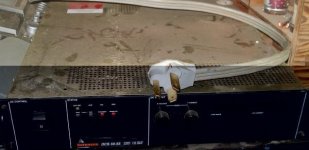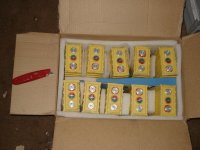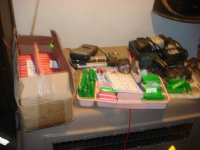So I'm tired of hauling around lead bricks for power, and had an unexpected opportunity to get enough Li-Ion cells to give me the range I would really like to have, assuming I can make them work without blowing myself up. 
I'm currently collecting the rest of the information and parts I need to build the packs from. I've been reading about doing this for a couple of years now, and back at the beginning even started collecting "dead" laptop batteries, when I could get them for free, so I could harvest the still-good cells to build packs from. Unfortunately there usually were few if any cells worth saving, by the time I was given them, due to the time they sat around uncharged. So that idea went nowhere fast, as an ebike power pack. (I did build a better pack for my own laptop, though).
So that idea went nowhere fast, as an ebike power pack. (I did build a better pack for my own laptop, though).
I'm figuring on 36V 10Ah packs for now, which will be paralleled to run the bike from. Each pack will take 50 (or 60, depending on sag under load) cells, so that should give me 5 or 6 packs. This will make it easier to find places on the bike to put them. It's possible I may go with 12V packs instead, to make it easier to series them for 48V or higher later on.
I run 45-ish pounds of 36V 18Ah SLA currently, using used server-UPS batteries. That gets me, with judicious use of pedals, 15 miles at 12-16MPH with frequent stops/starts for traffic controls. That's using my old motor, a 300W-ish, maybe 350, 2-pole brushed PMDC powerchair motor. I've now got a much heftier motor at 650W, also a powerchair motor, which I'm still working out the gearing for. It's a 4-pole brushed PMDC, with way more torque, and a totally different efficiency curve I'm still figuring out.
Typically with the old motor I pulled up to at least 20A battery current during acceleration depending on the gear I was in and the slope. Average current would be more like 4A to 10A. Terrain here is pretty flat, but there are some hills, and most of the big ones are very long, up to several miles at small grades, but often with a section of higher-grade here and there; two notable ones are enough that I would have to walk this bike up to the top rather than ride it, as even with the motor (the old one) I wouldn't be able to reach the top without either running out of battery or overheating the motor or both.
The new motor pulls probably more instantaneous current, but I haven't got a meter that will read higher than that right now. However, that current is pulled for a much shorter time, as it takes much less time to get up to speed with it. Average, it pulls around 4A-8A doing the same thing the other motor did. Not sure why it would be less (I expected it to be more, due to 4 poles).
The controller is a customized 2QD, so in theory I could do regen braking if I work out a clutch for the motor (so I can still coast) and take out the freewheel in the post-motor drivetrain. Right now the pedals and motor both feed into the main regular 21-speed bicycle drivetrain. The new motor has so much torque it can actually pop the chain over the teeth of the rear sprockets in higher gears. Not a problem I ever expected to have, so I'm still rethinking the drivetrain to possibly fix that. (I have a newer chain and cassette to try first).
Not a problem I ever expected to have, so I'm still rethinking the drivetrain to possibly fix that. (I have a newer chain and cassette to try first).
On to the batteries (which I've not yet got in hand, but want to work out stuff before they arrive if I can):
They're 18650 sized, most of them Sanyo UR18650F, spec sheet here:
http://www.datasheetarchive.com/UR18650F-datasheet.html
or here in case that isn't working at some point:
http://www.houseofbatteries.com/pdf/UR18650F
The rest are Sony but I don't remember their p/n.
So they're nominally 3.7V 2.1Ah cells; I'll just round that down to 3.6V 2Ah and be happy for any extra.
Charging current is listed as 1C @ 4.2V, for 2.5 hours.
Assuming 3.6V start voltage and 3.0V LVC, I could draw up to 2C out of them to still get around 2Ah. I'd rather draw much less from any one cell, since I need range more than I need massive power for any length of time, excluding those rare hills.
I'd prefer to charge in the same configuration I discharge in, so I'd like to build a BMS for it. I'm still reading thru the fairly long threads that contain lots of BMS information, and I will probably end up building one of them from scratch on perfboard, using whatever parts I have laying around here. (I can't afford to buy or make PCBs, or else I'd get the ones from TPPacks and populate them with closest equivalents I have in my junkboxes. I've already spent my month's grocery money on the batteries themselves, plus some will go for the Turnigy watt meter if the order goes thru).
At first, to test the cells, I'll be charging them one at a time with a Sorenson linear adjustable voltage/current 60VDC 1.5A current-limited lab power supply, which I use right now to charge the third SLA in my pack (a 24V 3A wheelchair charger is used for the other two). Later, I will use the same supply to charge them as packs, at it's higher voltage. Yeah, it'll take at least all night to charge if I fully discharge the packs, but it's the best one I've got right now.
I have a bunch of other linear power supplies that I can probably convert to chargers, but they're not current-limited yet, and most are much lower voltage (one is only 5v, but up to 200A).
I also have a bunch of 4V-6V celphone chargers that I am considering turning into a portable charger system, if I have enough of them that are isolated so I can series their outputs, to use for opportunity trickle charging. Got a bunch of higher-voltage (12V-15V) laptop power supplies that can supply lots more current, if I can series those, to use instead. Have to work out a BMS before I can use either method, though.
Any constructive criticism, questions, or suggestions are welcome.
I'm currently collecting the rest of the information and parts I need to build the packs from. I've been reading about doing this for a couple of years now, and back at the beginning even started collecting "dead" laptop batteries, when I could get them for free, so I could harvest the still-good cells to build packs from. Unfortunately there usually were few if any cells worth saving, by the time I was given them, due to the time they sat around uncharged.
I'm figuring on 36V 10Ah packs for now, which will be paralleled to run the bike from. Each pack will take 50 (or 60, depending on sag under load) cells, so that should give me 5 or 6 packs. This will make it easier to find places on the bike to put them. It's possible I may go with 12V packs instead, to make it easier to series them for 48V or higher later on.
I run 45-ish pounds of 36V 18Ah SLA currently, using used server-UPS batteries. That gets me, with judicious use of pedals, 15 miles at 12-16MPH with frequent stops/starts for traffic controls. That's using my old motor, a 300W-ish, maybe 350, 2-pole brushed PMDC powerchair motor. I've now got a much heftier motor at 650W, also a powerchair motor, which I'm still working out the gearing for. It's a 4-pole brushed PMDC, with way more torque, and a totally different efficiency curve I'm still figuring out.
Typically with the old motor I pulled up to at least 20A battery current during acceleration depending on the gear I was in and the slope. Average current would be more like 4A to 10A. Terrain here is pretty flat, but there are some hills, and most of the big ones are very long, up to several miles at small grades, but often with a section of higher-grade here and there; two notable ones are enough that I would have to walk this bike up to the top rather than ride it, as even with the motor (the old one) I wouldn't be able to reach the top without either running out of battery or overheating the motor or both.
The new motor pulls probably more instantaneous current, but I haven't got a meter that will read higher than that right now. However, that current is pulled for a much shorter time, as it takes much less time to get up to speed with it. Average, it pulls around 4A-8A doing the same thing the other motor did. Not sure why it would be less (I expected it to be more, due to 4 poles).
The controller is a customized 2QD, so in theory I could do regen braking if I work out a clutch for the motor (so I can still coast) and take out the freewheel in the post-motor drivetrain. Right now the pedals and motor both feed into the main regular 21-speed bicycle drivetrain. The new motor has so much torque it can actually pop the chain over the teeth of the rear sprockets in higher gears.
On to the batteries (which I've not yet got in hand, but want to work out stuff before they arrive if I can):
They're 18650 sized, most of them Sanyo UR18650F, spec sheet here:
http://www.datasheetarchive.com/UR18650F-datasheet.html
or here in case that isn't working at some point:
http://www.houseofbatteries.com/pdf/UR18650F
The rest are Sony but I don't remember their p/n.
So they're nominally 3.7V 2.1Ah cells; I'll just round that down to 3.6V 2Ah and be happy for any extra.
Charging current is listed as 1C @ 4.2V, for 2.5 hours.
Assuming 3.6V start voltage and 3.0V LVC, I could draw up to 2C out of them to still get around 2Ah. I'd rather draw much less from any one cell, since I need range more than I need massive power for any length of time, excluding those rare hills.
I'd prefer to charge in the same configuration I discharge in, so I'd like to build a BMS for it. I'm still reading thru the fairly long threads that contain lots of BMS information, and I will probably end up building one of them from scratch on perfboard, using whatever parts I have laying around here. (I can't afford to buy or make PCBs, or else I'd get the ones from TPPacks and populate them with closest equivalents I have in my junkboxes. I've already spent my month's grocery money on the batteries themselves, plus some will go for the Turnigy watt meter if the order goes thru).
At first, to test the cells, I'll be charging them one at a time with a Sorenson linear adjustable voltage/current 60VDC 1.5A current-limited lab power supply, which I use right now to charge the third SLA in my pack (a 24V 3A wheelchair charger is used for the other two). Later, I will use the same supply to charge them as packs, at it's higher voltage. Yeah, it'll take at least all night to charge if I fully discharge the packs, but it's the best one I've got right now.
I have a bunch of other linear power supplies that I can probably convert to chargers, but they're not current-limited yet, and most are much lower voltage (one is only 5v, but up to 200A).
I also have a bunch of 4V-6V celphone chargers that I am considering turning into a portable charger system, if I have enough of them that are isolated so I can series their outputs, to use for opportunity trickle charging. Got a bunch of higher-voltage (12V-15V) laptop power supplies that can supply lots more current, if I can series those, to use instead. Have to work out a BMS before I can use either method, though.
Any constructive criticism, questions, or suggestions are welcome.






